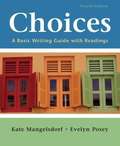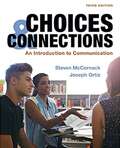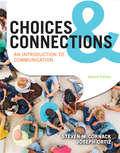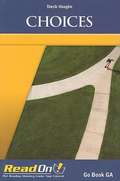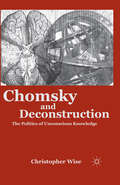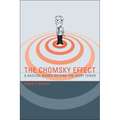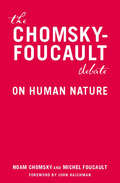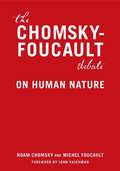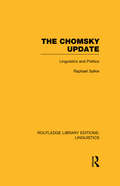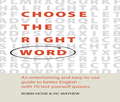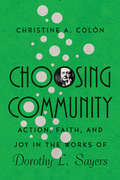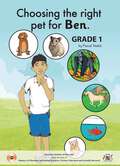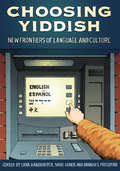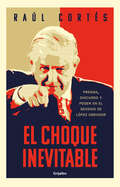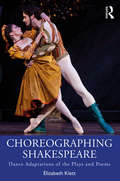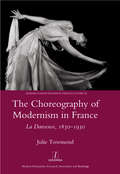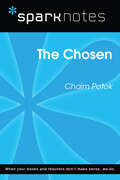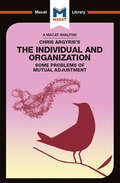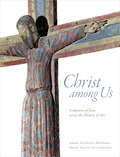- Table View
- List View
Choices: A Basic Writing Guide with Readings (4th edition)
by Kate Mangelsdorf Evelyn PoseyChoices gives students detailed help with the skills needed for successful writing in college, from understanding writing as a process to taking essay exams, from using rhetorical strategies to conducting research.
Choices and Connections: An Introduction to Communication for the University of New Haven
by Steven McCornack Joseph OrtizIn this book, the authors systematically guide students how they can apply communication skills and principles to difficult situations and better adapt to daily demands in their own lives. Beyond the Advance the Conversation activities, the book also includes annotated visuals, sample speech outlines, and two visually annotated sample speeches. Through features such as Advance the Conversation, the book systematically guides students through challenging and thought-provoking communication scenarios, so that they can use their skills to better adapt to life's daily demands.
Choices And Connections: An Introduction To Communication
by Steven McCornack Joseph OrtizChoices & Connections shows students that communication is an opportunity to connect their words and actions to their choice of who they want to be and what kind of community they want to live in. Every element in the text is designed to engage students in the study of communication and help them become resilient, confident, and culturally conscious communicators. Choices & Connections helps students integrate and apply the most current scholarly research through scenario activities, real-life situations, and pop-culture examples designed to recursively develop communication skills best learned through practice, in context. The third edition has been extensively revised to ensure that all students’ perspectives are represented. The coverage of gender communication has been overhauled, with a reimagined Chapter 3 on “Understanding Gender and Culture.” The mediated communication chapter has also been heavily revised with the latest research.
Choices & Connections: An Introduction to Communication
by Steven Mccornack Joseph OrtizBased on decades of teaching experience combined with the latest in research and communication theory, Steve McCornack and Joseph Ortiz’s Choices & Connections, 2e helps students to transform their lives and become more adaptive and versatile communicators. With a focus on the connections that underlie all communication choices—and that the outcomes students experience are deeply connected to the communication choices they make—Choices & Connections, 2e weaves together major communication contexts so that students’ understanding becomes cohesive. Captivating students from page one, the text is highlighted by built-in study tools, innovative video case study activities, and a variety of news, pop culture, and real-life examples—all of which encourage students to apply what they learn to their own their daily communication experiences. When combined with LaunchPad, Choices & Connections, 2e represents a unique print and digital learning suite: the How to Communicate video activities immerse students in challenging, real-life scenarios, and additional videos illustrate communication concepts, and the adaptive quizzing program, LearningCurve, creates a personalized learning experience. LaunchPad for Choices & Connections, 2e combines an interactive e-book, integrated videos, and ready-made assessment options curated into easy-to-assign units inside one convenient learning program. The second edition LaunchPad also includes new in-class activities for students to further engage with the course material, and with each other.
Choices in Literature (Bronze)
by Globe FearonThis book engages the student in reading to learn, the more you read, the more to learn about the outside world, expounding your creativity; increase the choices they make in life; by reading actively you gain skills that will bring you to a successful life.
Choices (Read On! Go Book GA)
by Harcourt Achieve20 short stories designed to increase reading comprehension.
Chomsky
by Smith, Neil and Allott, Nicholas Neil Smith Nicholas AllottNoam Chomsky continues to be one of the most influential intellectual figures of modern times. His wide-ranging contributions to the fields of linguistics, psychology, philosophy and politics have revolutionised our view of language, the mind and human nature. Assuming no prior knowledge of linguistics, this book explores Chomsky's key theories, especially recent developments in his Minimalist Program, addressing issues such as: how do we know a language? How do children acquire this knowledge? How did language evolve? This third edition has been expanded and thoroughly updated and includes an exploration of Chomsky's contributions to philosophy and psychology, outlining the impact of his radical and often controversial views. It concludes with an account of his political activism and his critique of recent developments such as the Arab Spring, Wikileaks and the Occupy movement. There is also a new section covering his views on climate change and nuclear disarmament.
Chomsky and Deconstruction: The Politics of Unconscious Knowledge
by Christopher WiseThis book offers a careful and measured response to Noam Chomsky's criticism against deconstructive theories of language. The author reveals the connections between Chomsky's linguistic theories and politics by demonstrating their shared philosophical basis.
The Chomsky Effect: A Radical Works Beyond the Ivory Tower
by Robert F. Barsky"People are dangerous. If they're able to involve themselves in issues that matter, they may change the distribution of power, to the detriment of those who are rich and privileged." --Noam Chomsky. Noam Chomsky has been praised by the likes of Bono and Hugo Chavez and attacked by the likes of Tom Wolfe and Alan Dershowitz. Groundbreaking linguist and outspoken political dissenter--voted "most important public intellectual in the world today" in a 2005 magazine poll--Chomsky inspires fanatical devotion and fierce vituperation. In "The Chomsky Effect," Chomsky biographer Robert Barsky examines his subject's positions on a number of highly charged issues--Chomsky's signature issues, including Vietnam, Israel, East Timor, and his work in linguistics--that illustrate not only "the Chomsky effect" but also "the Chomsky approach." Chomsky, writes Barsky, is an inspiration and a catalyst. Not just an analyst or advocate, he encourages people to become engaged--to be "dangerous" and challenge power and privilege. The actions and reactions of Chomsky supporters and detractors and the attending contentiousness can be thought of as "the Chomsky effect." Barsky discusses Chomsky's work in such areas as language studies, media, education, law, and politics, and identifies Chomsky's intellectual and political precursors. He charts anti-Chomsky sentiments as expressed from various standpoints, including contemporary Zionism, mainstream politics, and scholarly communities. He discusses Chomsky's popular appeal--his unlikely status as a punk and rock hero (Eddie Vedder of Pearl Jam is one of many rock and roll Chomskyites)--and offers in-depth analyses of the controversies surrounding Chomsky's roles inthe "Faurisson Affair" and the "Pol Pot Affair." Finally, Barsky considers the role of the public intellectual in order to assess why Noam Chomsky has come to mean so much to so many--and what he may mean to generations to come.
The Chomsky-Foucault Debate: On Human Nature
by Noam Chomsky Michel FoucaultIn this historic 1971 debate, two of the twentieth century&’s most influential thinkers discuss whether there is such a thing as innate human nature. In 1971, at the height of the Vietnam War and at a time of great political and social instability, two of the world&’s leading intellectuals, Noam Chomsky and Michel Foucault, were invited by Dutch philosopher Fons Elders to debate an age-old question: Is there such a thing as &“innate&” human nature independent of our experiences and external influences? The resulting dialogue is one of the most original, provocative, and spontaneous exchanges to have occurred between contemporary philosophers. Above all, their discussion serves as a concise introduction to their two opposing theories. What begins as a philosophical argument rooted in linguistics (Chomsky) and the theory of knowledge (Foucault), soon evolves into a broader discussion encompassing a wide range of topics, from science, history, and behaviorism to creativity, freedom, and the struggle for justice in the realm of politics. In addition to the debate itself, this volume features a newly written introduction by noted Foucault scholar John Rajchman and includes substantial additional texts by Chomsky and Foucault. &“[Chomsky is] arguably the most important intellectual alive.&” —The New York Times &“Foucault . . . leaves no reader untouched or unchanged.&” —Edward Said
The Chomsky-Foucault Debate: On Human Nature
by Noam Chomsky Michel FoucaultTwo of the twentieth century's most influential thinkers debate a perennial question. In 1971, at the height of the Vietnam War and at a time of great political and social instability, two of the world's leading intellectuals, Noam Chomsky and Michel Foucault, were invited by Dutch philosopher Fons Edlers to debate an age-old question: is there such a thing as "innate" human nature independent of our experiences and external influences? The resulting dialogue is one of the most original, provocative, and spontaneous exchanges to have occurred between contemporary philosophers, and above all serves as a concise introduction to their basic theories. What begins as a philosophical argument rooted in linguistics (Chomsky) and the theory of knowledge (Foucault), soon evolves into a broader discussion encompassing a wide range of topics, from science, history, and behaviorism to creativity, freedom, and the struggle for justice in the realm of politics. In addition to the debate itself, this volume features a newly written introduction by noted Foucault scholar John Rajchman and includes additional text by Noam Chomsky.
The Chomsky Update: Linguistics And Politics (Routledge Library Editions: Linguistics)
by Raphael SalkieNoam Chomsky has been described as ‘arguably the most important intellectual alive’. His revolutionary work in linguistics has aroused intense scholarly interest, while his trenchant critique of United States foreign policy and his incisive analysis of the role of intellectuals in modern society have made him a prominent public figure. Raphael Salkie’s timely book introduces the two parts of Chomsky’s work and explores the connections between them. He provides an accessible and up-to-date introduction to Chomsky’s linguistics, laying out his basic assumptions and aims – in particular, his consistent drive to make linguistics a science – and looking at a sample of Chomsky’s recent work. He examines the implications for other fields such as philosophy and psychology, as well as the main challenges to Chomsky’s position. Raphael Salkie also sets out the key themes in Chomsky’s political writings and his libertarian socialist views. He contrasts the ‘official line’ on US foreign policy – the view that the US is a ‘well-meaning, blundering giant’ – with Chomsky’s carefully argued alternative view. By focusing on Chomsky’s conception of human nature and human freedom the author draws out the links between the two sides of Chomsky’s work, in the belief that both sides raise issues which can profitably be explored. The author also provides a carefully annotated guide to further reading. As an experienced teacher of linguistics with a commitment to political activism, Raphael Salkie is uniquely qualified to present this introduction to one of the seminal thinkers of our time. First published in 1990.
Choose The Right Word: An Entertaining And Easy-to-use Guide To Better English- With 70 Test Yourself Quizzes
by Robin Hosie Vic MayhewWhether applying for a job, writing a letter of complaint or simply talking with colleagues or friends, the people who get listened to are those with a confident command of language. Choose the Right Word is a fun guide to using English effectively and to avoiding common mistakes. It is both a valuable work of reference and an enjoyable read. While plotting a path through a minefield of rules and conventions, the book acknowledges that English is an ever-changing language and points out those rules that can at times be broken. 70 light-hearted quizzes show you how to use words that will make your point powerfully, and usage tips set you right on contextual issues. Curio Corners tell the fascinating stories behind dozens of everyday words and phrases. What's the difference between affect and effect; abjure and adjure? Does AD for Anno Domino come before or after the year - and the century? Should you write all right or alright; adviser or advisor? How did the word alcohol come into our language? Just how sure are you about your apostrophes?
Choose The Right Word: An entertaining and easy-to-use guide to better English- with 70 test yourself quizzes
by Vic Mayhew Robin HosieWhether applying for a job, writing a letter of complaint or simply talking with colleagues or friends, the people who get listened to are those with a confident command of language. Choose the Right Word is a fun guide to using English effectively and to avoiding common mistakes. It is both a valuable work of reference and an enjoyable read. While plotting a path through a minefield of rules and conventions, the book acknowledges that English is an ever-changing language and points out those rules that can at times be broken. 70 light-hearted quizzes show you how to use words that will make your point powerfully, and usage tips set you right on contextual issues. Curio Corners tell the fascinating stories behind dozens of everyday words and phrases. What's the difference between affect and effect; abjure and adjure? Does AD for Anno Domino come before or after the year - and the century? Should you write all right or alright; adviser or advisor? How did the word alcohol come into our language? Just how sure are you about your apostrophes?
Choosing Community: Action, Faith, and Joy in the Works of Dorothy L. Sayers (Hansen Lectureship Series)
by Christine A. ColònFew writers in the twentieth century were as creative and productive as Dorothy L. Sayers, the English playwright, novelist, and poetDivine ComedyAmong the prominent themes of her work was the need for and challenges of developing community. Sayers, who was herself an active member of various writing groups throughout her lifetime, offers her readers visions of both fractured and harmonious communities.In this Hansen Lectureship volume, Christine Colón explores the role of community in Sayers's works. In particular, she considers how Sayers offers a vision of communities called to action, faith, and joy, and she reflects on how we also are called to live in community together.Based on the annual lecture series hosted at Wheaton College's Marion E. Wade Center, volumes in the Hansen Lectureship Series reflect on the imaginative work and lasting influence of seven British authors: Owen Barfield, G. K. Chesterton, C. S. Lewis, George MacDonald, Dorothy L. Sayers, J. R. R. Tolkien, and Charles Williams.
Choosing The Right Pet for Ben class 1 - MIE
by Dr Pascal Nadal"Choosing The Right Pet for Ben" is a charming children's book centered around Ben's desire for a birthday pet. Faced with Ben's imaginative choices like a protective gorilla or a fast horse, his parents gently guide him toward more feasible options like a cat, dog, or fish. Through a delightful dialogue, the book navigates Ben's initial outlandish requests, offering a glimpse into his innocent aspirations and parental guidance. It cleverly discusses various animals, their habitats, and appropriateness as pets, culminating in Ben's decision to adopt a hamster, fostering a heartwarming resolution. The book not only captivates young readers with its engaging narrative but also imparts subtle lessons about responsible pet ownership, animal habitats, and the importance of making practical choices. With its colorful illustrations, simple language, and relatable characters, this story is tailored to resonate with Grade 1 pupils, serving as a valuable educational tool in developing literacy skills and sparking curiosity about pets and their environments.
Choosing Yiddish: New Frontiers of Language and Culture
by Dara Horn Jeffrey Shandler Jeremy Dauber Josh Lambert Barbara Kirshenblatt-Gimblett Kalman Weiser Hasia Diner Ari Y. Kelman Tony Michels Gennady Estraikh Sarah Bunin Benor Anita Norich Rebecca Margolis Zehavit Stern Asya Vaisman Shiri Goren Lara Rabinovitch Gerben Zaagsma Edward Portnoy Jennifer Young Ela Bauer Shachar Pinsker Shayn Smulyan Adriana X. Jacobs Barbara Mann Jordan Finkin Rebecca Kobrin Hannah S. Pressman Anna ShternshisYiddish Hip Hop, a nineteenth-century "Hasidic Slasher," obscure Yiddish writers, and immigrant Jewish newspapers in Buenos Aires, Paris, and New York are just a few of the topics featured in Choosing Yiddish: New Frontiers of Language and Culture. Editors Lara Rabinovitch, Shiri Goren, and Hannah S. Pressman have gathered a diverse and richly layered collection of essays that demonstrates the currency of Yiddish scholarship in academia today.Organized into six thematic rubrics, Choosing Yiddish demonstrates that Yiddish, always a border-crossing language, continues to push boundaries with vigorous disciplinary exchange. "Writing on the Edge" focuses on the realm of belles lettres; "Yiddish and the City" spans the urban centers of Paris, Buenos Aires, New York City, and Montreal; "Yiddish Goes Pop" explores the mediating role of Yiddish between artistic vision and popular culture; "Yiddish Comes to America" focuses on the history and growth of Yiddish in the United States; "Yiddish Encounters Hebrew" showcases interactions between Yiddish and Hebrew in the late nineteenth and twentieth centuries; and "Hear and Now" explores the aural dimension of Yiddish in contemporary settings. Along the way, contributors consider famed and lesser-known Yiddish writers, films, and Yiddish hip-hop, as well as historical studies on the Yiddish press, Yiddish film melodrama, Hasidic folkways, and Yiddish culture in Israel. Venerable scholars introduce each rubric, creating additional dialogue between newer and more established voices in the field.The international contributors prove that the language--far from dying--is fostering exciting new directions of academic and popular discourse, rooted in the field's historic focus on interdisciplinary research. Students and teachers of Yiddish studies will enjoy this innovative collection.
El choque inevitable: Prensa, discurso y poder en el sexenio de López Obrador
by Raúl Cortés¿Por qué López Obrador se ha obsesionado con los medios (sobre todo con los "conservadores"), a quienes considera sus más fieros contrincantes? ¿Por qué miente y desinforma con tanta confianza incluso cuando se le presentan evidencias que anulan sus afirmaciones? ¿Qué consecuencias políticas tiene su actitud retadora y desdeñosa hacia la verdad y los hechos? Sea como un recurso para polarizar al país en su beneficio o como una genuina estrategia de cambio, el presidente de México ha logrado convertir la relación entre el poder y los medios de comunicación en uno de los aspectos centrales de su gestión. Esto ha generado confrontación, pero también dependencia, y ha marcado el ritmo de la discusión pública en México desde que el presidente estableció las conferencias "mañaneras" como la principal vía de comunicación de su gobierno. Este libro registra y analiza esa interdependencia. Mitad crónica de los primeros cuatro años de gobierno de AMLO, centrada en los bulos que se han lanzado día tras día desde el púlpito del presidente, y mitad ensayo sobre el uso político de las fake news y el papel de la ética periodística en un mundo dominado por la desinformación y la infodemia, es uno de los textos que mejor documentan un fenómeno tan complejo como preocupante: las implicaciones políticas de la posverdad.
Choral Mediations in Greek Tragedy
by Renaud Gagné Marianne Govers HopmanThis volume explores how the choruses of Ancient Greek tragedy creatively combined media and discourses to generate their own specific forms of meaning. The contributors analyse choruses as fictional, religious and civic performers; as combinations of text, song and dance; and as objects of reflection in themselves, in relation and contrast to the choruses of comedy and melic poetry. Drawing on earlier analyses of the social context of Greek drama, the non-textual dimensions of tragedy, and the relations between dramatic and melic choruses, the chapters explore the uses of various analytic tools in allowing us better to capture the specificity of the tragic chorus. Special attention is given to the physicality of choral dancing, musical interactions between choruses and actors, the trajectories of reception, and the treatment of time and space in the odes.
Choreographing Shakespeare: Dance Adaptations of the Plays and Poems
by Elizabeth KlettChoreographing Shakespeare presents a hitherto unexplored history of the choreographers and performers who have created dance adaptations of Shakespeare. This book investigates forty dance works in genres such as ballet, modern dance, and hip-hop, produced between 1940 and 2016 by choreographers in Britain, America, and Europe, all of which use Shakespeare’s plays and Sonnets as their source material. By combining scholarly analysis of these productions with practice-based conversations from six contemporary choreographers, Klett offers both breadth of coverage and in-depth analysis of how Shakespeare’s poetic language is translated into the usually wordless medium of dance, and shows exactly how these dance adaptations move beyond the Shakespearean texts to engage with musical and choreographic influences. Ideal for students of Shakespeare and Dance Studies, Choreographing Shakespeare explores how dance adaptations strive to design legible and intelligible stories, while ultimately celebrating the beauty of pure movement.
The Choreography of Modernism in France: La Danseuse 1830-1930
by Julie Townsend"Whether in the pages of a trashy novel, in the glow of gaslights, in a dance hall, or on the walls of art galleries, the figure of the female dancer haunts nineteenth-century French culture. Artists and writers of all kinds took on la danseuse as an emblem of their own artistic prowess. They represented her alternately as an elusive ideal, a saucy prostitute, or a dangerous seductress. Dancers, in turn, produced their own images, novels and autobiographies, thereby contributing to an ongoing cultural debate around performance, spectatorship, desire, and art. In this interdisciplinary study of la danseuse, Julie Townsend examines the rise and fall of classical ballet, the phenomenon of the music hall, and the birth of modern dance. She highlights moments of representational crisis and emergent aesthetics in her consideration of poetry, novels, painting, early film, and women's autobiography."
The Chosen (SparkNotes Literature Guide Series)
by SparkNotesThe Chosen (SparkNotes Literature Guide) by Chaim Potok Making the reading experience fun! Created by Harvard students for students everywhere, SparkNotes is a new breed of study guide: smarter, better, faster.Geared to what today's students need to know, SparkNotes provides:chapter-by-chapter analysis explanations of key themes, motifs, and symbols a review quiz and essay topics Lively and accessible, these guides are perfect for late-night studying and writing papers.
Chris Argyris's Integrating The Individual and the Organization (The Macat Library)
by Stoyan StoyanovArgyris’s Integrating The Individual and the Organization is part of a series of essays and books considering how organisations should be run. This essay explores the lack of congruence between the needs and expectations of individual employees and the organisations that employ them. Grounding his argument in studies on human nature, Argyris highlights that demands of greater independence, an expansion of interests, and re-orientation of goals usually accompany maturation, which is at odds with higher control stemming from formal organisations. This frustration, he contends, is detrimental to productivity, increases the chance of failure and causes conflict.
Chris Ware: Conversations (Conversations with Comic Artists Series)
by Jean BraithwaiteVirtuoso Chris Ware (b. 1967) has achieved some noteworthy firsts for comics. The Guardian First Book Award for Jimmy Corrigan: The Smartest Kid on Earth was the first major UK literary prize awarded for a graphic novel. In 2002 Ware was the first cartoonist included in the Whitney Biennial. Like Art Spiegelman or Alison Bechdel, Ware thus stands out as an important crossover artist who has made the wider public aware of comics as literature. His regular New Yorker covers give him a central place in our national cultural conversation. Since the earliest issues of ACME Novelty Library in the 1990s, cartoonist peers have acclaimed Ware’s distinctive, meticulous visual style and technical innovations to the medium. Ware also remains a literary author of the highest caliber, spending many years to create thematically complex graphic masterworks such as Building Stories and the ongoing Rusty Brown. Editor Jean Braithwaite compiles interviews displaying both Ware’s erudition and his quirky self-deprecation. They span Ware’s career from 1993 to 2015, creating a time-lapse portrait of the artist as he matures. Several of the earliest talks are reprinted from zines now extremely difficult to locate. Braithwaite has selected the best broadcasts and podcasts featuring the interview-shy Ware for this volume, including new transcriptions. An interview with Marnie Ware from 2000 makes for a delightful change of pace, as she offers a generous, supremely lucid attitude toward her husband and his work. Candidly and humorously, she considers married life with a cartoonist in the house. Brand-new interviews with both Chris and Marnie Ware conclude the volume.
Christ among Us: Sculpted Images of Jesus from across the History of Art
by Joseph Antenucci Becherer Henry Martin LuttikhuizenNo single figure has been more often featured in Western art than Jesus Christ. Sculptures, particularly—though they have received less notice than paintings—provide some of the most moving representations in their capacity to show Christ alongside us in three-dimensional space.In this &“catalog for an imagined exhibition,&” two prominent art historians—one from the Roman Catholic tradition, one from the Protestant tradition—offer a guided tour of fifty-two sculptures of Jesus Christ from throughout the Western world. The chronological scope of the selection ranges from the third century to the present, with the work of well-known sculptors featured alongside the work of less familiar artists who deserve more attention.Along with lush, high-resolution photographs, each piece is accompanied by an essay that places it in context and brings it to life, so readers can experience the sculpture almost as vividly as they would in person. Those interested in devotional as well as artistic significance will find inspiration in the striking representations of Christ in his many forms: healer, sage, sovereign, and savior, from his humble yet majestic birth to his harrowing death and miraculous resurrection.
